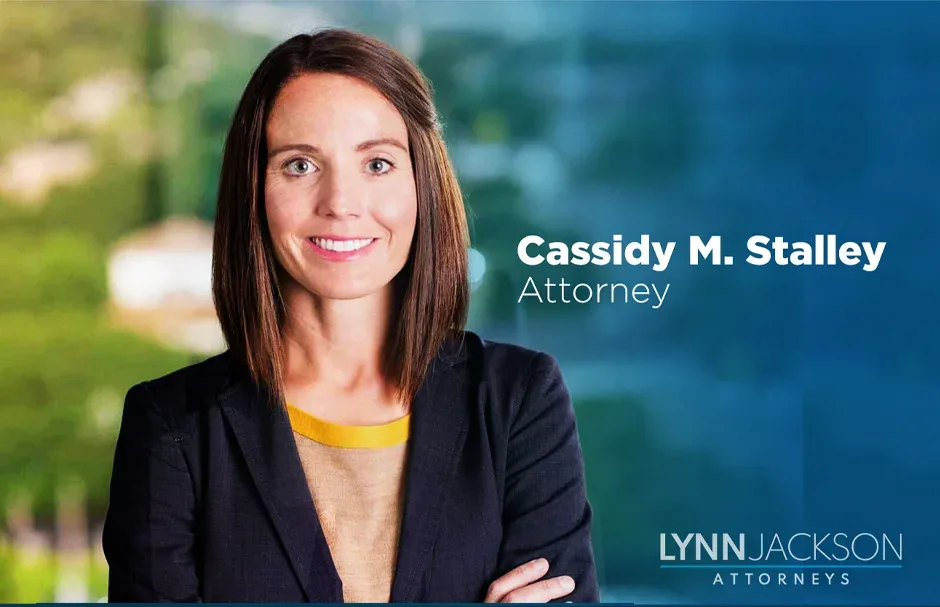Championing The Vulnerable: The Crucial Role of Advocacy For Abused And Neglected Children
Cassidy Stalley is a partner at Lynn, Jackson, Shultz & Lebrun in Rapid City, South Dakota. Her primary practice area is in litigation. She graduated, magna cum laude, from the University of Mary in Bismarck, North Dakota, and obtained her law degree, with honors, from the University of South Dakota. Cassidy was a judicial clerk for the Second Judicial Circuit of South Dakota before entering private practice.
Cassidy is an AV-rated attorney. In 2019, she was selected by the Pennington County Bar Association as Outstanding Young Lawyer. Cassidy is a volunteer youth soccer coach and President of the Rapid City Catholic School System School Board. Cassidy and her husband Jared have three children. They enjoy playing sports, boating, and exploring the great outdoors.
When I was a brand-new lawyer, my mentor and partner encouraged me to take judicial appointments for abused and neglected children. She noted the great need for quality representation, but also thought it would be a way for me to get in front of our circuit judges and that it would serve as a valuable training ground as a litigator.
My mentor was so wise.
In South Dakota, abuse and neglect proceedings are civil proceedings. Any child alleged to be abused or neglected is appointed an attorney who represents the child’s best interests and may not be the attorney for any other party involved in the proceedings. Attorneys who feel called to represent children are required to complete training developed by the South Dakota Unified Judicial System and be certified abuse and neglect trained attorneys. The abuse and neglect docket is handled by a single circuit judge; the docket rotates approximately every twelve to eighteen months.
Children come into the State’s custody and the court system through mandatory reporters, private citizen referrals, pick-up and place orders, and law enforcement. After a child is taken into temporary custody, an emergency temporary custody hearing is required to be held within forty-eight hours, excluding Saturdays, Sundays, and court holidays. Attorneys for the parents and children are appointed at or prior to the emergency temporary custody hearing.
If continued custody is granted at the emergency temporary custody hearing, I then meet with the child or children, as well as with the foster parents or family members who the child or children have been placed with for the pendency of the case. Depending on a child’s age, I explain my role, and if old enough, ask a child what he or she wants to happen or what he or she wants the judge to know. As you can imagine, generally all children want to be returned to the custody of their parents. But occasionally, children voice that they would rather be somewhere safe and not with their parents.
Throughout the case, I rely on the Department of Social Services to provide me with updates, but I also routinely check in with the children, as well as the foster parents or family placements to hear how a child is doing and if there are any concerns.
After the initial emergency temporary custody hearing, additional hearings are generally scheduled every thirty to sixty days. A typical abuse and neglect case can take anywhere from three to twelve months, or beyond. An abuse and neglect case ends in either dismissal, with custody being returned to the parents, a guardianship, or termination of parental rights.
Since becoming a certified abuse and neglect trained attorney in 2013, I have been appointed to approximately 170 cases and represented over 315 children. I have appeared nearly weekly in front of six different circuit court judges. I have taken a few cases to the Supreme Court of South Dakota and established new law. And my experience has been invaluable.
Indeed, I have been involved in numerous contested and evidentiary hearings, in which I have had to cross-examine witnesses, including parents whose rights are about to be terminated, Department of Social Services employees who are overworked and often inexperienced, Indian Child Welfare Act experts, and even physicians, generally all on the fly. Certainly, as an attorney, I am provided with discovery throughout the case, including the Department of Social Service’s records, notes, and narratives, as well as police reports, medical records, and other agency investigative reports. But when a witness gets up to testify, particularly a parent, you must be prepared for anything in these cases. There are no depositions, interrogatories, or requests for production of documents. Instead, I have learned to know the record inside and out and honed my listening and observation skills. Without a doubt, these hearings have enhanced my cross-examination skills in my litigation practice.
Not to mention the hundreds of little lives I have tried to make better through my advocacy for their best interests. I have held tiny babies addicted to meth, held space with teenagers who make the brave decision to testify against their parents and request that their parents’ parental rights be terminated, and held back tears of joy when parents put in the work to change their behaviors and become better parents for their children.
I now encourage all new attorneys to consider becoming certified abuse and neglect trained attorneys. As my mentor observed long ago, being a certified abuse and neglect trained attorney has been an invaluable training ground in a legal landscape where jury trials are becoming few and far between. I view my role as a service to the bar, but more importantly, to the greater good. I have been blessed with the skills and work ethic to be an effective advocate. I am grateful that I can use those skills for the least among us, in hopes that I can somehow change their lives for the better.
